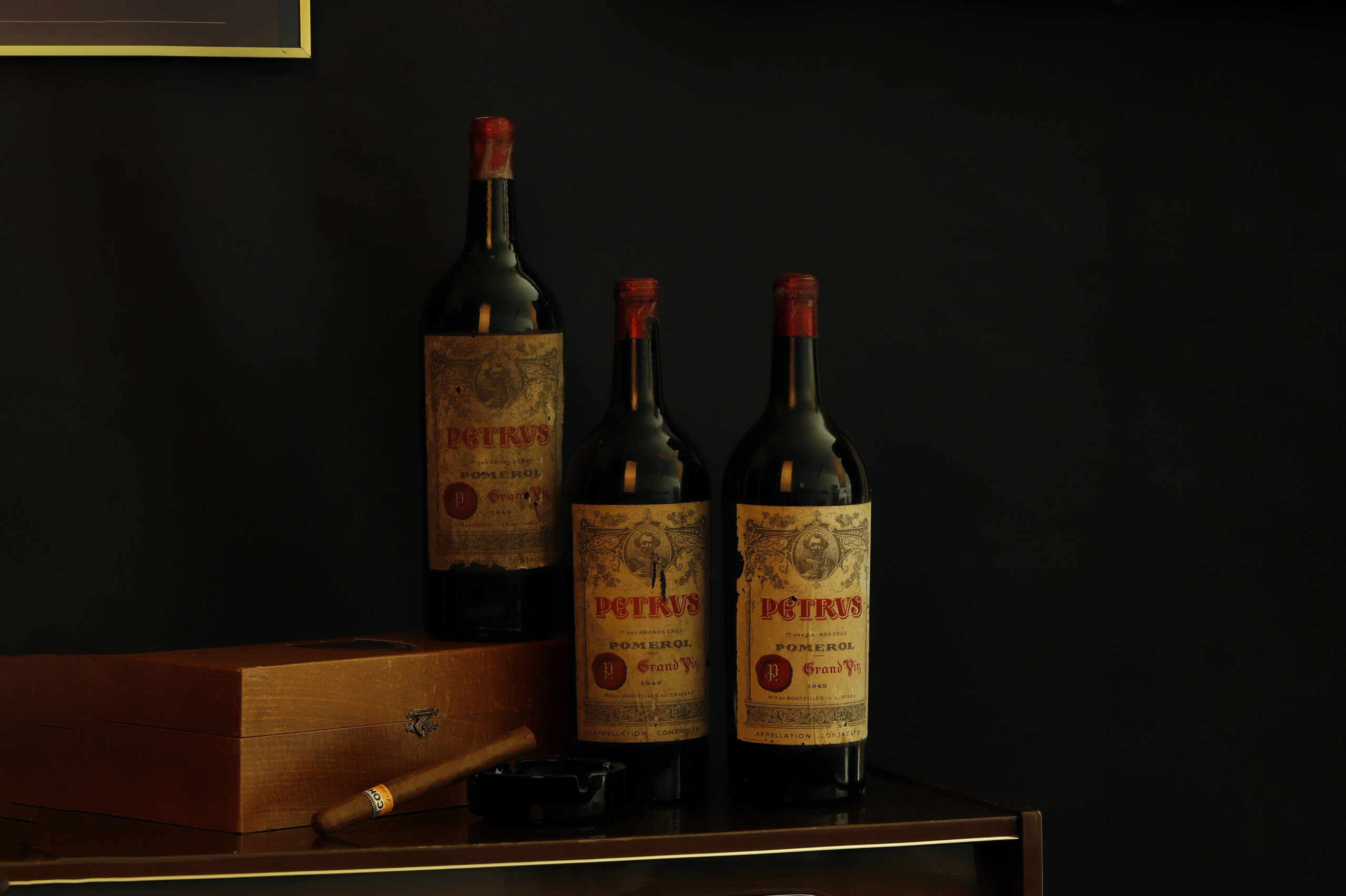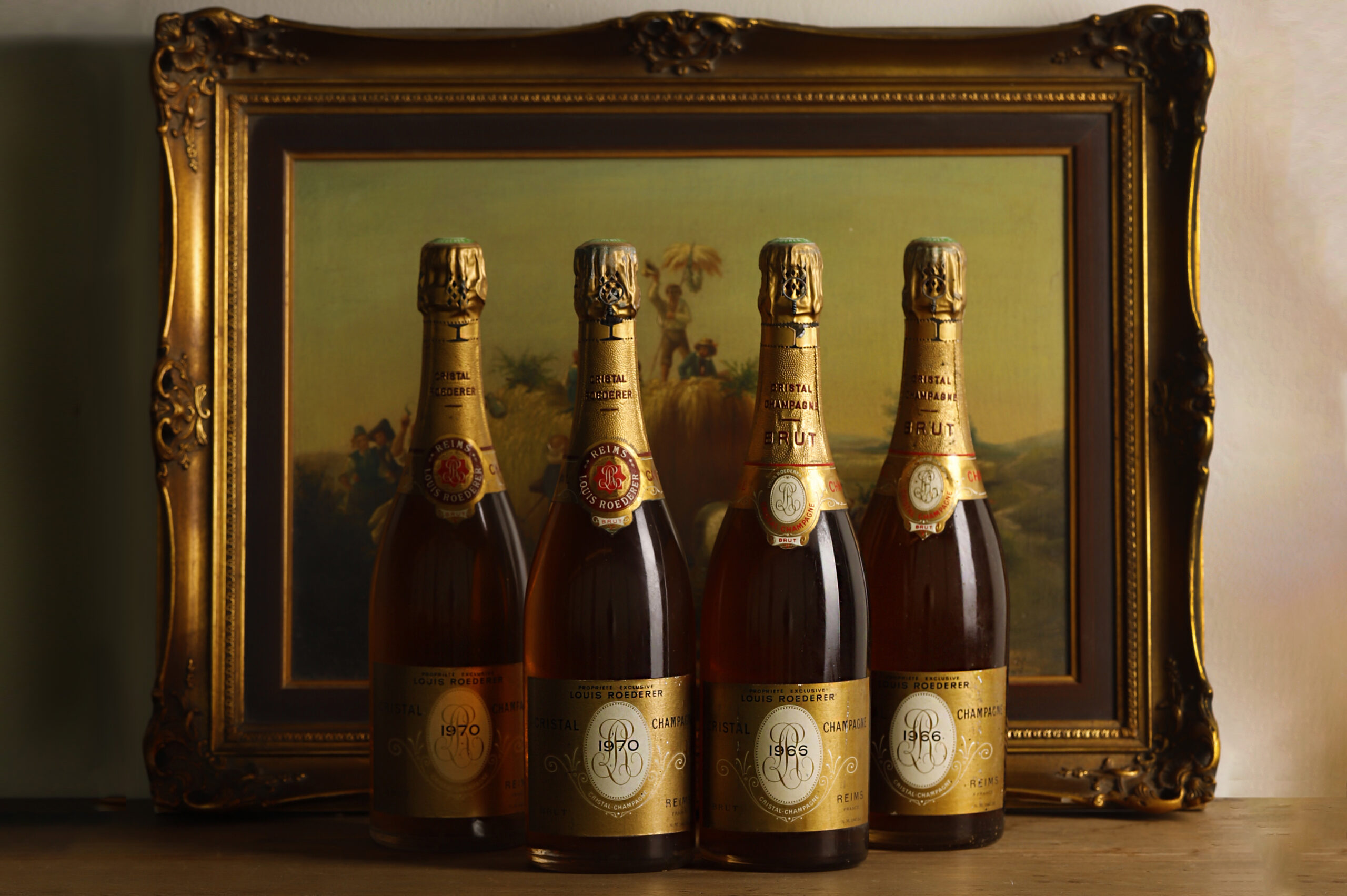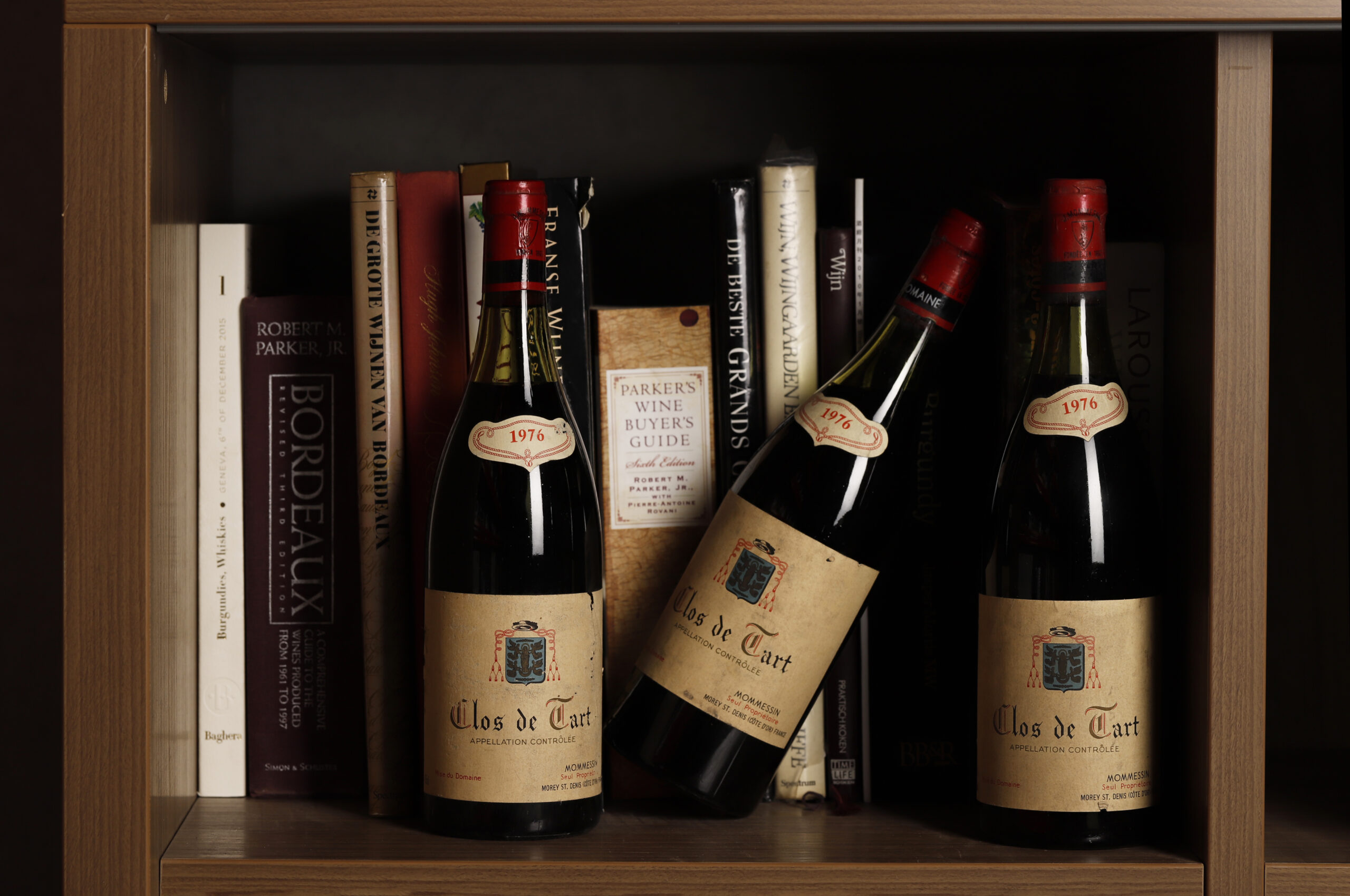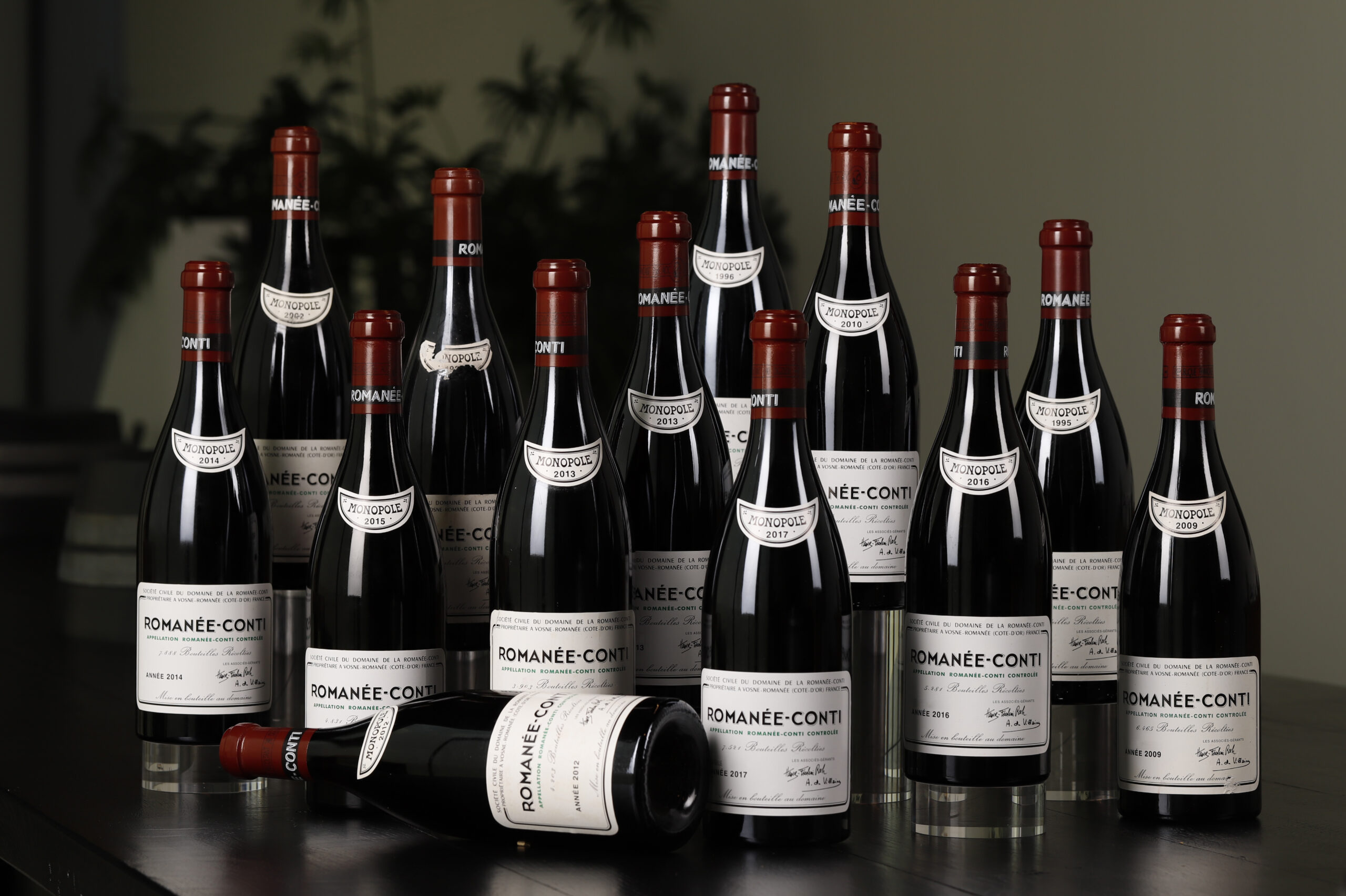Online wine auction platform for the most luxurious wines and champagnes
Wine Auction 21

Petrus
During auction 21 we had a multiple lots of the great Petrus. There were 37 bottles divided over 20 lots, among them were vintages from 1947 to 2011.
Lot 252 had 3 bottles of Magnum Petrus from 1949 and had no less than 36 bids. This lot was knocked off at €31000.
The wine Petrus was born in 1837.
From the beginning he was seen as one of the greats of Pomerol.
In 1940 Madame Loubat was the sole owner of this domain. When she died in the 1960s, the Moueix family took over.
The world fame of Petrus started in 1945 which was an excellent year. Now The area of these beautiful wines is located in the east of Pomerol. Where they sell about 30,000 bottles of this divine drink a year.
In the east of Pomerol lie the vineyards of Petrus. The soil, full of dark clay and rich in iron, is ideally suited to the development of the Merlot grape.
The success of the wine is partly due to its geographical location. With a size of just over 11 hectares, the vineyard is relatively small. Its proximity to the port of Libourne ensured that the wine was shipped throughout Europe. Just after the Second World War, the real fame of Petrus came with the exceptional vintages of 1945 and 1947.
In 1947, Pétrus was even served at the Queen's wedding.
Another famous fan of the wine is former President of the United States John F. Kennedy.
Today, many people will state Petrus as their most favourite wine in the world. James Suckling even has an article on his website saying: "Petrus is my favourite wine."

Cristal is a prestigious Champagne produced by the renowned Champagne house Louis Roederer. It is considered one of the finest and most luxurious Champagne brands available. Here are some key points about Cristal:
History and Origin: The history of Cristal dates back to 1876 when Tsar Alexander II of Russia requested that Louis Roederer create a special Champagne for his personal consumption. This led to the creation of Cristal, which was initially produced exclusively for the Russian imperial family. The Champagne was originally bottled in clear crystal glass, which gave it its distinctive name.
Luxury and Exclusivity: Cristal is known for its exclusivity and luxury. It's produced in limited quantities and is often associated with high-end events, celebrations, and luxury establishments. The wine's reputation for quality and elegance has made it a symbol of luxury and refinement.
Terroir and Grapes: Cristal is typically made from a blend of Chardonnay and Pinot Noir grapes sourced from the best vineyards owned by Louis Roederer. The grapes come from Grand Cru and Premier Cru vineyards, ensuring the highest quality fruit.
Vinification: The production of Cristal involves meticulous attention to detail. Grapes are carefully selected and harvested by hand. The wine undergoes a traditional Champagne-making process, including fermentation, blending, and aging. It is aged in the cellars for an extended period to develop its complex flavors and aromas.
Bottle Design: Cristal is distinctive not only for its exceptional quality but also for its unique packaging. The Champagne is presented in clear glass bottles with an anti-UV cellophane wrapper to protect the wine from light.
Taste Profile: Cristal is known for its finesse, balance, and elegance. It often displays notes of citrus, white flowers, toast, and mineral undertones. The wine's flavor profile can evolve over time as it ages, developing greater complexity.
Aging Potential: Cristal is known for its aging potential, and it can improve in the bottle over several years. Many collectors choose to cellar Cristal to enjoy its evolution and maturity.
Price and Rarity: Due to its limited production, reputation, and luxurious image, Cristal is one of the more expensive Champagnes on the market. The price can vary depending on the vintage and the size of the bottle.
Cristal remains a symbol of luxury, elegance, and excellence in the world of Champagne. It's often associated with special occasions, celebrations, and moments of indulgence.

A Taste of History
Over 900 years of tradition, knowledge and hard work was poured into one of Burgundy’s finest wines. Clos de Tart is not only a beautiful wine, it is a legacy. A vineyard that has been worked and ploughed through for almost a millennia, it’s truly a taste of history.
Our 21st wine auction had the opportunity to auction a variety of Clos de Tart, ranging from 1921 to 1990.
The oldest and largest Grand Cru Monopole
The origins of Clos de Tart can be traced all the way back to 1141. The 7.5 ha estate was founded by Cistercian nuns of the Tart Abbey, a dependent house of Cîteaux Abbey. Before these nuns acquired the land, it was called Climat de la Forge, a relatively unknown climat. They were the first to work the soil and create the vineyard. The domain remained in possession of this order until 1791, during the French Revolution.
It was after 1791, when the Marey-Monge family took over, that Clos de Tart started it’s rise to fame.
In 1855, Clos de Tart was given the prestigious classification of “Tête de Cuvée”, a classification that is even more difficult to achieve than the current Grand Cru classification! It was also the only Estate in the whole of Morey-Saint-Denis who was given this honour.
The Marey-Monge family continued to push Clos de Tart to it’s limits all the way up to 1932, where they sold off the estate at an auction. It was Henri Mommessin, a Mâcon wine merchant, who had bought the estate. He appointed Sylvain Pitiot to uphold and elevate the status that Clos de Tart already had, and he did exactly that.
The Mommessin family remained the sole owners of the estate until 2018, where the estate had its latest shift in ownership. This time it was the Pinault family who became the sole owners, adding to their list of wine estates, along with Château Latour and Domaine D’Eugénie in Vosne-Romanée.
Notice how the estate, since 1141, has only ever been in possession of one single party?
First the Cistercian nuns of the Tart Abbey, then the Marey-Monge family, then the Mommessin family and lastly the Pinault family.
Clos de Tart is the oldest Grand Cru Monopole with traceable records of ownership. Besides this already prestigious title, it also upholds being the largest Grand Cru Monopole, boasting a 7.5 ha domain.
Clos de Tart is a historical pillar of status, tradition and innovation.
To this day, it still stands strong alongside the top of Burgundy.
Our most expensive lot sold for €1125, being 3 bottles of 1976 Clos de Tart.
Our most sought-after lot had 9 biddings, being 1 bottle of 1959 Clos de Tart.
Take a look at all of our available bottles during this auction.

The Romanée-Conti vineyard is one of the most famous and revered vineyards in the world, located in the Burgundy wine region of France. It is renowned for producing some of the most exceptional and sought-after Pinot Noir wines. Here are some key points about the Romanée-Conti vineyard:
Location: The Romanée-Conti vineyard is situated in the Côte de Nuits subregion of Burgundy, specifically within the village of Vosne-Romanée. It is a relatively small vineyard, covering just over 1.8 hectares (around 4.5 acres).
Ownership: The vineyard is owned by the Domaine de la Romanée-Conti (DRC), which is often considered one of the most prestigious and exclusive wine producers in the world. The domaine also owns other notable vineyards in the region, including La Tâche, Richebourg, and Montrachet.
Terroir: The Romanée-Conti vineyard has a unique and complex terroir, characterized by its limestone-rich soil and optimal exposure to sunlight. The combination of soil composition, microclimate, and the expertise of the DRC team contributes to the vineyard's ability to produce wines of exceptional quality and character.
Production: The wines from the Romanée-Conti vineyard are made exclusively from Pinot Noir grapes. The vineyard is divided into several distinct plots, each contributing to the complexity of the final blend. The winemaking process at Domaine de la Romanée-Conti is meticulous, involving traditional techniques and careful attention to detail.
Wine Quality: Romanée-Conti wines are known for their elegance, finesse, and ability to age gracefully. They often display a combination of red fruit flavors, floral aromatics, and a distinct sense of terroir. The wines are highly sought after by collectors, connoisseurs, and enthusiasts.
Rarity and Price: Due to the limited size of the vineyard and the prestige associated with the Domaine de la Romanée-Conti, the wines are produced in very small quantities. As a result, they are among the most expensive wines in the world, with prices that can reach astronomical levels, especially for older vintages.
Cultural Significance: The Romanée-Conti vineyard holds a special place in the world of wine as a symbol of excellence and craftsmanship. Its wines are often considered benchmarks for what Pinot Noir can achieve in terms of complexity, depth, and expression of terroir.
In summary, the Romanée-Conti vineyard is an iconic and revered site in Burgundy, producing wines that are considered some of the finest expressions of Pinot Noir in the world. Its limited production, exceptional quality, and historical significance contribute to its legendary status among wine enthusiasts.



